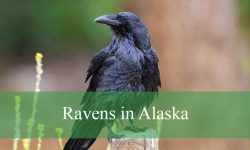Scorpions are fascinating arachnids that often go unnoticed in Alabama’s diverse ecosystems. Though not very common, several scorpion species call the state home, each with unique features and behaviors. Understanding these creatures can help reduce fear and promote appreciation for their role in nature.
In Alabama, scorpions mostly inhabit wooded areas, leaf litter, and rocky crevices where they hunt insects and other small prey at night. While their appearance may seem intimidating, most local scorpions are not dangerous to humans and tend to avoid contact.
This guide covers five types of scorpions you might encounter in Alabama, providing detailed identification tips, habitat information, and interesting facts.
Common Scorpions Found in Alabama
Southern Devil Scorpion (Vaejovis carolinianus)
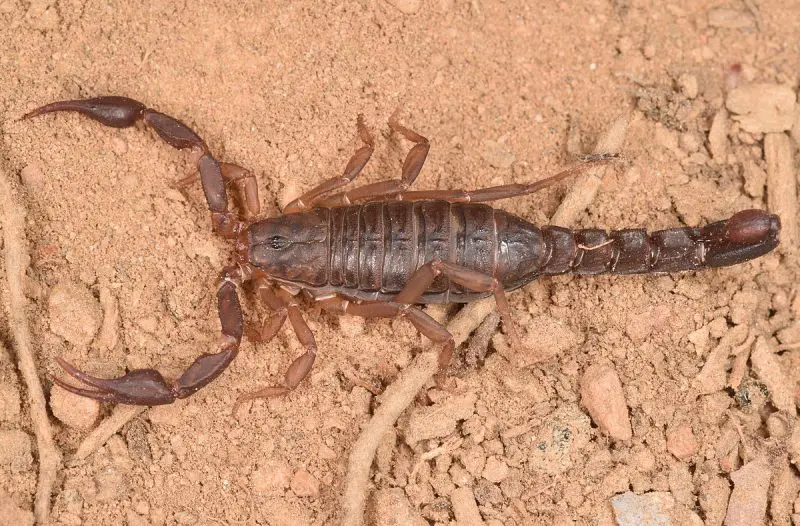
The Southern Devil Scorpion is one of the few scorpions native to the southeastern United States, including Alabama. It typically has a dark brown to black coloration that helps it blend into the forest floor. This species measures around 2 to 3 inches (5 to 7.5 cm) in length, making it medium-sized compared to other scorpions. Its pincers are relatively robust, and its tail is moderately thick and curved.
Southern Devil Scorpions are mostly nocturnal and spend their days hiding under rocks, logs, leaf litter, or inside crevices. They are shy and non-aggressive towards humans but will sting if provoked. Their sting is usually mild, causing localized pain similar to a bee sting. Identification of this scorpion is made easier by its dark color and habitat preferences.
In terms of behavior and diet, Southern Devil Scorpions are opportunistic predators. They feed primarily on small insects, spiders, and other arthropods. Their hunting strategy involves ambushing prey or slowly stalking them before delivering a venomous sting to immobilize their target. They rely on their pincers to grasp prey and their venom to subdue it.
This species favors moist, wooded environments such as forests, woodlands, and shaded ravines. In Alabama, they are most commonly found in the northern and central parts of the state, where there is abundant leaf litter and decaying wood. They are important in controlling insect populations in their ecosystem.
Striped Bark Scorpion (Centruroides vittatus)
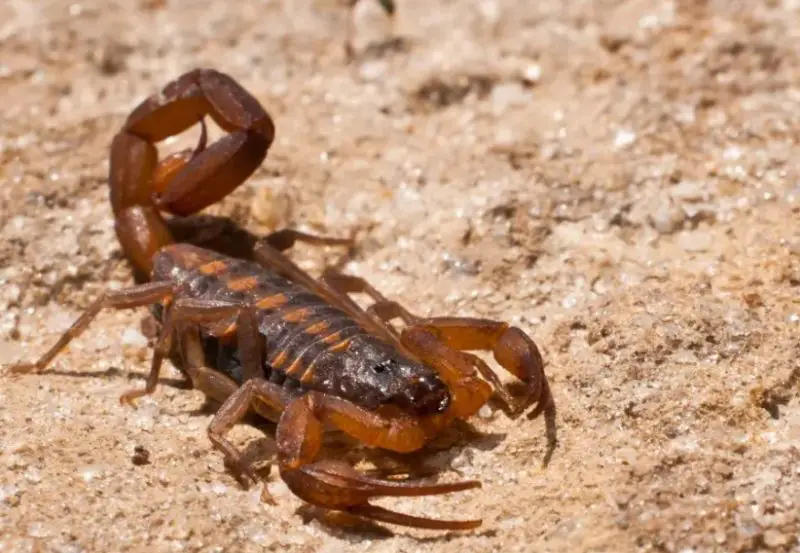
The Striped Bark Scorpion is recognized by its slender body and distinctive dark stripes running lengthwise along its pale yellow or tan back. Adults typically grow to about 2.5 to 3.5 inches (6.4 to 9 cm) long. Its pincers are thin and elongated, adapted for quick movements rather than strong gripping. This species is quite agile compared to other scorpions.
This scorpion is primarily nocturnal, often found climbing trees, fences, or walls during the night in search of prey. During the day, it hides in bark crevices, under stones, or in sheltered cracks. Though it has been mostly documented in southwestern states, there have been occasional sightings in Alabama, likely due to accidental transport or range expansion.
Striped Bark Scorpions hunt insects and other small arthropods using a combination of speed and venom. They actively pursue prey rather than ambushing it. Their venom is more potent than that of many other species in Alabama but is rarely dangerous to humans, causing only localized pain and swelling in most cases.
This species prefers dry, warm habitats but is highly adaptable. In Alabama, it is usually found in urban or suburban areas where suitable hiding places are available. Its ability to climb vertical surfaces allows it to exploit a wide range of environments from wooded areas to buildings.
Little Brown Scorpion (Centruroides gracilis)
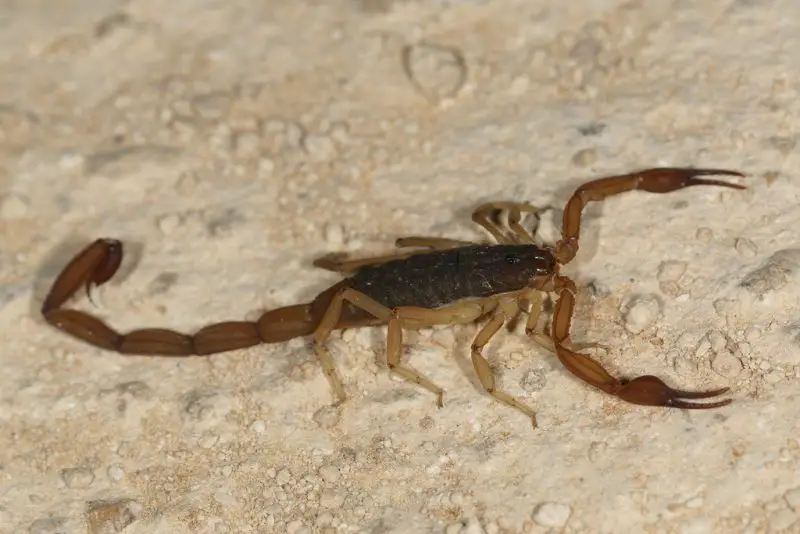
The Little Brown Scorpion is a smaller species, usually measuring about 1.5 to 2 inches (4 to 5 cm) in length. Its coloration ranges from light brown to tan with slightly darker markings on its back and pincers. Its slender body and tail give it a delicate appearance compared to bulkier scorpions.
Behaviorally, the Little Brown Scorpion is nocturnal and tends to be more reclusive than other species. It typically hides under rocks, logs, and debris during the day and emerges at night to hunt. When threatened, it may quickly flee rather than stand its ground. Its sting is mild but can cause localized irritation or pain.
This scorpion preys on small insects and arthropods, using its venom to subdue them. It hunts primarily by stalking and grabbing prey with its pincers before delivering a venomous sting. Its hunting strategy relies on stealth and quick strikes rather than prolonged chases.
The Little Brown Scorpion prefers warm, dry habitats such as sandy soils, open woodlands, and occasionally residential areas with loose debris. In Alabama, it is most commonly found in southern regions where the climate is warmer. It is less frequently encountered compared to other species but plays an important role in controlling insect populations.
Dwarf Scorpion (Microtityus species)
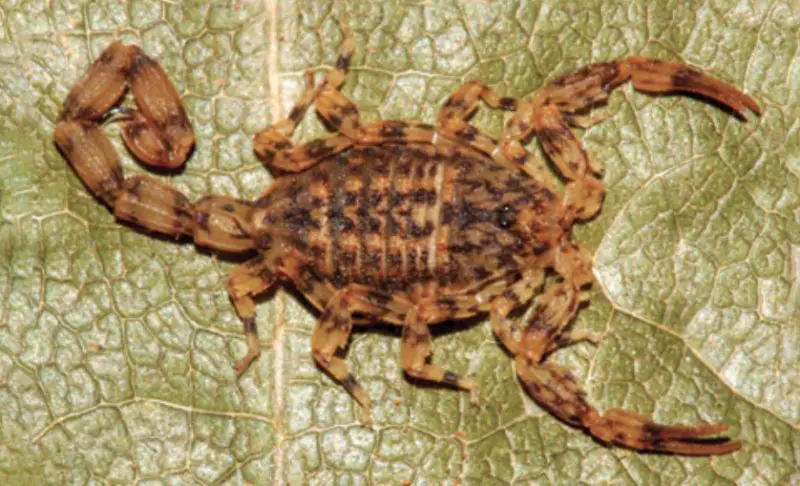
Dwarf Scorpions belong to a genus of very small scorpions that typically measure less than 2 inches (5 cm) in length. They have a compact body and are often lighter in color, ranging from pale yellow to light brown. Their small size and cryptic coloration make them difficult to spot in the wild.
These scorpions are secretive and elusive, usually hiding under bark, leaf litter, or within soil crevices during the day. They are strictly nocturnal and emerge at night to hunt. Because of their small size, they tend to avoid confrontation and quickly retreat when disturbed. Their sting is weak and not considered harmful to humans.
Dwarf Scorpions feed mainly on tiny insects, larvae, and other small arthropods. They rely on stealth and quick strikes to capture prey, using their pincers to seize and hold it while delivering venom to immobilize. Their small size limits their prey range but allows them to occupy microhabitats inaccessible to larger scorpions.
In Alabama, these scorpions inhabit moist, forested areas with abundant ground cover and decaying plant matter. They are rarely seen due to their size and secretive habits but contribute to the local ecosystem by controlling populations of very small insects and arthropods.
Eastern Striped Scorpion (Centruroides hentzi)

The Eastern Striped Scorpion is a medium-sized scorpion typically measuring 2 to 3 inches (5 to 7.5 cm) in length. It has a distinctive pattern of dark stripes running longitudinally down its yellowish-brown body. The pincers are slender, and the tail is relatively long and flexible.
This species is primarily nocturnal and tends to be active during warm months. It hides under rocks, logs, bark, and debris during the day. While generally non-aggressive toward humans, it will sting if handled or provoked. The sting can cause localized pain and swelling but is not medically significant.
Eastern Striped Scorpions prey mainly on insects and small arthropods, using a combination of speed and venom to subdue them. Their hunting involves actively searching for prey at night, grabbing it with pincers, and injecting venom with the stinger. They play an important role in natural pest control.
In Alabama, this scorpion is found mostly in the southern and central parts of the state, favoring dry, sandy, or rocky habitats such as pine forests, open woodlands, and sandy soils. It can also be found in suburban areas where suitable shelter exists.
FAQs about Scorpions in Alabama
What types of scorpions are found in Alabama?
Alabama is home to several species of scorpions, including the Southern Devil Scorpion (Vaejovis carolinianus), Striped Bark Scorpion (Centruroides vittatus), Little Brown Scorpion (Centruroides gracilis), Dwarf Scorpion (Microtityus species), and the Eastern Striped Scorpion (Centruroides hentzi).
Are scorpions dangerous in Alabama?
Most scorpion species in Alabama are not dangerous to humans. Their stings can cause mild to moderate pain and localized swelling similar to a bee sting. However, they rarely cause serious medical problems unless a person is allergic to the venom.
Where do Alabama scorpions typically live?
Scorpions in Alabama prefer moist wooded environments, leaf litter, under rocks, logs, and bark. Some species, like the Striped Bark Scorpion, can also be found in urban areas hiding in crevices, fences, or trees.
How can I identify a scorpion in Alabama?
Alabama scorpions vary in size from small (around 1.5 inches) to medium-sized (up to 3.5 inches). They typically have pincers and a segmented tail with a stinger. Coloration ranges from dark brown to pale yellow with some species having distinctive stripes or markings.
What should I do if I get stung by a scorpion?
If stung, clean the area with soap and water, apply a cold pack to reduce pain and swelling, and take over-the-counter pain relievers if needed. Most stings heal without complications. Seek medical attention if you experience severe pain, allergic reactions, or symptoms like difficulty breathing.
Do scorpions help the environment?
Yes, scorpions are beneficial predators that help control populations of insects and other small arthropods, playing an important role in maintaining ecological balance.
How can I prevent scorpions from entering my home?
To reduce the chances of scorpions entering your home, seal cracks and gaps in doors, windows, and foundations. Remove debris, woodpiles, and leaf litter near your house, and keep your yard well-maintained to limit suitable hiding spots.






